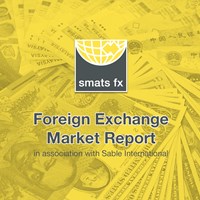
SMATS FX is proud to provide our weekly analysis of currency markets and exchange rates.
USA
The US Dollar was in the green last week, driven by optimism over the country’s economic recovery and increase in vaccinations. Jerome Powell and Yenet Yellen reinforced their dovish policy, indicating that they are confident in the rollout of the stimulus package that is currently being injected into the economy. Bond yields fell as the Fed appears satisfied with their use of available monetary tools and remain comfortable with allowing inflation to tick up in the short term. The resurgence of COVID-19 cases was a main catalyst that contributed to falling yields, which has the potential to stunt the regions recovery.
Weekly jobless claims were down to 648K, from 781K last week. Durable Goods Orders were down 1.1% in February, while Personal Income spending came in at -1.0% for the month. GDP grew by 4.3% in Q4 of last year while the current account deficit grew to $188.5billion in Q4. Manufacturing PMI for March came in at 59, up from 58.6 in February. This week, Non-Farm Payrolls will be released for March, after positive data in February. Unemployment rate data for March is also due this week.
HKD, SGD and AED
An empty docket for the exotic currency pairs this week, with very little in the way of economic data being released. The pairs moved mostly on global factors and the performance of the US dollar. Both AED and SGD made gains against the pound, with GBP/AED falling by 0.61% and GBP/SGD dipping by 0.34%.
The Hong Kong Dollar also benefitted from the winning performance of the US dollar, allowing the HKD to rise. The GBP/HKD and SGD/HKD pairs both depreciated, by 0.56% and 0.22% respectively. GBP/HKD closed the week around 10.70.
U.K
Sterling was supported fairly well by the U.K’s continued vaccination efforts, but was limited by a strong US dollar and concerns over the 3rd wave of COVID-19. The Bank of England meetings contributed to pound volatility, with investors eyeing the International Settlement Conference. The focus remains on unemployment, and while the BoE appears comfortable with allowing inflation to rise. Potential for negative interest rates has also holstered the pounds rally, and GBP/USD closed the week lower at 1.3785.
Unemployment figures were positive, down to 5.0%, with 86 000 new jobs created in February. Inflation for February was reported at 0.4%, down from YoY pre-pandemic levels of 0.7%. Manufacturing PMI was up to 57.9 in March, from 55.1 (MoM). Retail sales in February experienced 2.1% growth, after an 8.2% decline in January. This week, GDP growth and current account data will be released for Q4 2020.
EU
The Eurozone remains scattered with regards to their vaccination plan. Slow progress has limited the Euro, with EUR/USD reaching lows that haven’t been seen since last November. German growth expectations were cut to 3.7%, down from 4.2%, further weathering the struggling Euro. Concerns over vaccine export bans also contributed the Euro’s continued volatility & sell-off.
This week, March Consumer Confidence will be released for the Euro Area. Core Inflation Rate is will be out on Wednesday and is expected at 1.1% (YoY). A host of German data, including unemployment, retail sales, Manufacturing PMI and Balance of Trade will provide additional insight into the economic activity in the Eurozone.
AUD
The Aussie dollar performed comparatively well against the wave of dollar & sterling strength. GBP/AUD was up 0.78% last week, while USD/AUD advance by 1.40%.
Australia’s economy appears to be functioning well, with good control over the Coronavirus allowing the region to reach higher output levels. Manufacturing PMI for March rose slightly to 57, highlighting the countries strong bounce back.
This week, Balance of Trade figures for February are due, after January’s Trade Surplus of $10.15 billion. Retail Sales for February will also be released and is expected to decline by roughly 1%, after 0.3% growth in February. The Reserve Bank of Australia will also deliver their interest rate decision, which is expected to remain at 0.1%. Westpac Consumer Confidence and NAB Business Confidence will be reported for March, further providing insight into the state of economic activity.
NZD
The Kiwi dollar did not fare as well as it’s Aussie counterpart, With the AUD/NZD pair rising by 1.05%. The NZD felt more of the burn from developed market currencies and moved lower this last week, with GBP/NZD climbing above 1.96 during the weekly trade. This 1.83% rise was more manageable than the 2.46% rise in the USD/NZD pair during the week.
Data release for New Zealand was fairly light last week, Balance of Trade for February rose to $181 million. This week, the Reserve Bank of New Zealand is expected to leave its cash rate at 0.25% and provide an update on their LASP (Large Scale Asset Purchasing Program). This is expected to remain at $100 billion. Business PMI is for the region will be announced on Thursday, after February PMI declined to 53.4.
ZAR
South Africa’s inflation data for February was favourably low, reported at 2.9%. This further supports the SARB’s decision to keep rates at 3.5%, with no rate hikes expected for the next 6 months.
Despite lower-than-expected inflation figures, the rand was unable to escape undeniable dollar strength, which saw the ZAR depreciate against major developed-market currencies. The USD/ZAR pair was up by 2.02% last week, while GBP/ZAR advanced by 1.10%.
This week, we will hear more about the current state of South Africa’s economy through various data. Balance of Trade and Retail Sales for the month of February will be out, along with Manufacturing PMI for March.
Transfer your money internationally with ease at our special VIP rates at SMATS FX: http://www.smats.net/currency/
